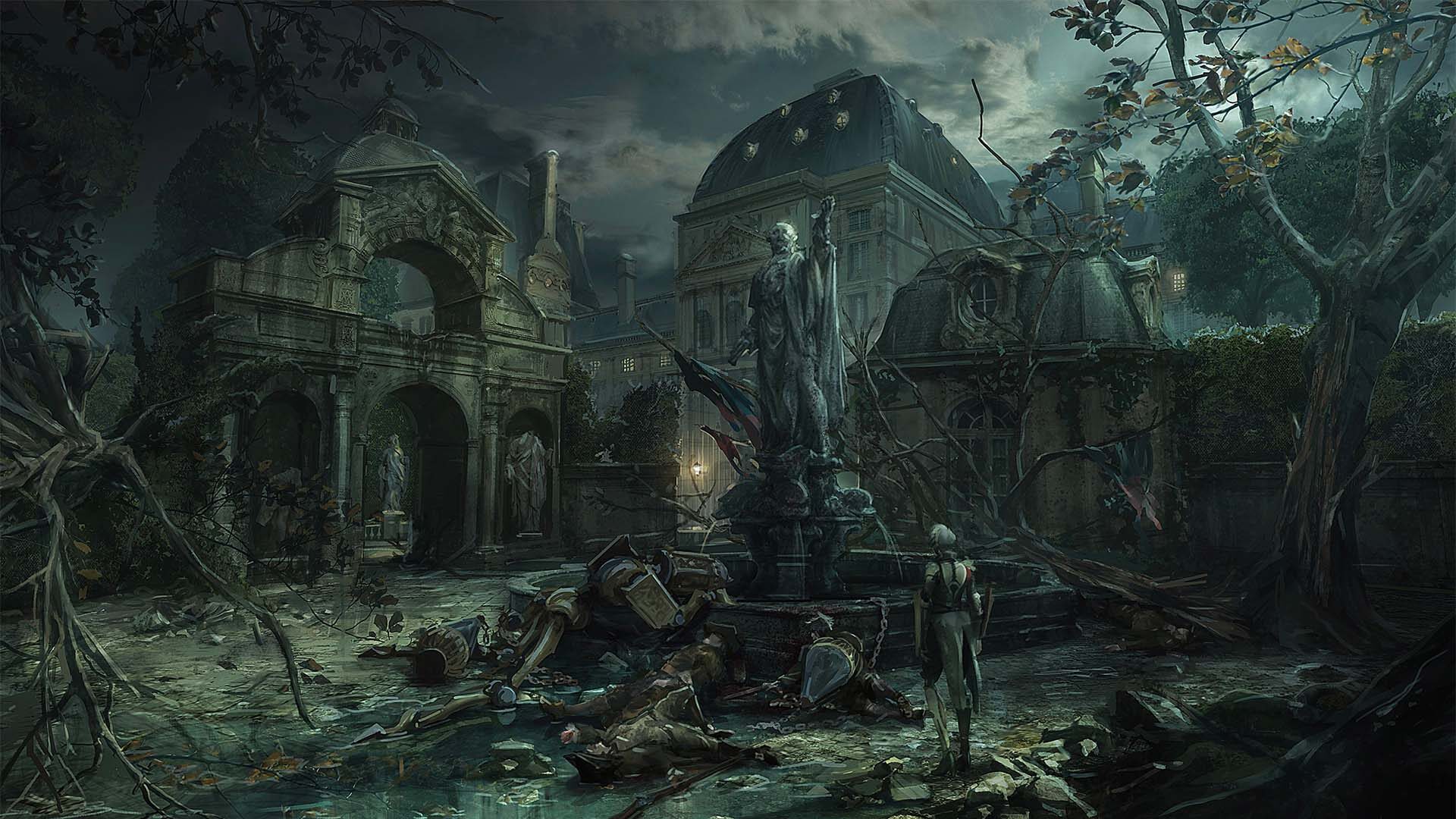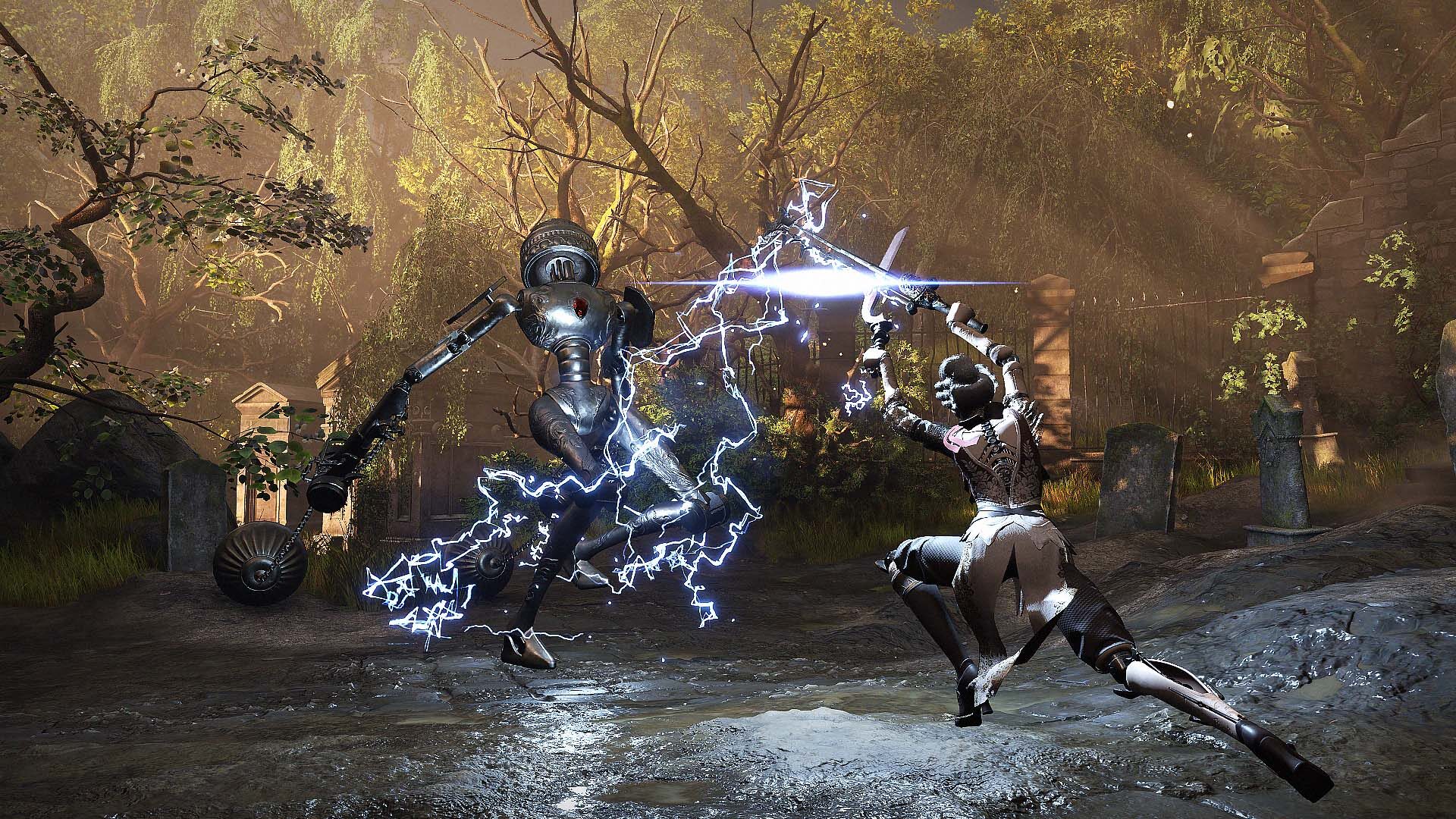Developer Spiders isn’t shy at all about making its soulslike influences in Steelrising obvious, both in and out of the game. In a brief presentation before letting us loose as a killer automaton fighting against the tyrannical forces of Louis XVI, the game’s reps referred to the game multiple times as a soulslike, both verbally and in writing. Looking at trailers, it’s clear where Spiders got its inspiration for Steelrising’s gameplay, but it’s not super common for a developer to outright admit that, yeah, it wanted to make a game like Dark Souls.
There’s something very annoying when games are clearly taking inspiration from other games but not actually referencing those games. I’m sure there are legal reasons why every developer that made climbing and a hang glider integral to their open-world traversal systems can’t admit that they’re just taking cues straight from Breath of the Wild, but it’s just… like, we know where you got that idea, dude. You can just say it. It’s fine. Breath of the Wild was great. We all liked it.
The same goes for when a project clearly apes Dark Souls’ design without admitting it. Oh, you have checkpoints where you can spend the experience you gained from defeating enemies to level up your character? And if you die, you drop that experience in a big, glowy bundle and will lose it forever if you die again before you can retrieve it? Does your character have a stamina meter that you need to carefully manage while trying not to die from powerful and dangerous foes? Wow, never heard of that before! Where’d you get that fantastic idea that’s not at all reminiscent of one of the most important and influential games of the last 20 years?
While playing through Steelrising’s opening section, I got the sense that Spiders didn’t have to waste any time trying to cleverly disguise what type of game it wanted to be. You’ve got light attacks, heavy attacks, and bonfires (called vestals) where you can spend souls (called Anima Essence) to level up your character’s attributes. Combat is all about dodging, counterattacking, occasionally utilizing throwables or special attacks, and not taking on too many enemies at once. You will fight your way through new areas just to unlock a door that was locked from the other side to give yourself a shortcut back to the bonfire. It’s literally Dark Souls. I know it, the developer knows it, we all know it.
There’s also the sense that everyone involved in Steelrising’s creation was unified in their ideas of exactly what kind of game it should be. This isn’t Star Wars Jedi: Fallen Order, where the popularity of the setting demanded that the game halfway repressed its soulslike desires. And it isn’t The Surge, which overly complicated its gear system for seemingly no reason other than to be different from Dark Souls. Steelrising is a soulslike in the most straightforward, obvious way, meaning the developer could refine its inspiration rather than fight against it.
One area where Steelrising sets itself apart is its setting and story. Taking place in Paris just a month before the storming of la Bastille, Steelrising presents an alternate, sci-fi, “clockpunk” vision of the French Revolution. Louis XVI has employed an army of automatons, based in part on the creations of real-life inventor Jacques de Vaucanson, to quell the revolution by any means necessary, with some violent and disturbing results. You play as Aegis, an automaton invented by Jacques’ fictional nephew, Eugene, to function as a dancer. Instead, Aegis became a killing machine and Queen Marie Antionette’s personal bodyguard. But when Louis practically imprisons the queen in a gilded cage, she sends Aegis on a mission to find and rescue her children (if they are still alive) and figure out a way to permanently disable Louis’ new army.

If there’s one complaint I have about Steelrising’s story and setting, it’s that there just isn’t enough of it, at least not in what I played. I experienced one cutscene at the beginning of my demo and another at the end. One featured the queen, and the other starred Lafayette—you know, the guy that helped win not one but two revolutionary wars. While both cutscenes portrayed their respective figures in questionable ways, at least as far as historical accuracy goes, it was at least unique to see an action RPG playing with this period of history and not be part of the Assassin’s Creed franchise. Moreso, I know that one of the strengths of the developer that made Greedfall is its storytelling, so it was a little disappointing to see that part of their repertoire toned down just because they are making a different kind of role-playing game.
Where Spiders have clearly made some strides, however, is in the “action” half of its action RPG. Steelrising’s combat is tough but very doable, especially compared to actual FromSoftware Souls and soulslikes. Though there were fewer enemy types than I would have liked, they were all pretty satisfying to fight, with readable attack patterns that punished mistakes but never felt unfair. Spiders fans will almost certainly agree that Steelrising’s combat is also a step up from Greedfall, though you could argue that both games have much different intentions. Still, it’s good to see the developer was up to the challenge of providing serviceable combat, especially in a genre where that’s the main draw.
Part of what makes Steelrising’s combat so much more fun than I was expecting—based on Spiders’ previous games and on my experience with other Soulslikes—is its weapon variety. All told, there are 8 different weapon types and 40 weapons total. I’m pretty sure I got to use at least one of each type, or close to it, and all the different weapons I used felt unique. The dual metal fans that I started with provided quick attacks and combo potential, but they didn’t do the most damage. However, they did offer another defensive option with their special move, which let me combine them to form a shield. A similar weapon type, in the form of two swords, did comparable damage, but instead of a block for their special move, they instead unleashed a flurry of spinning strikes that did a ton of damage if executed perfectly.
Heavier weapons obviously did more damage at the cost of slower attacks, which required a little more skill as you might expect. My favorite overall weapon was the fire chain. Its special move set the weapon on fire for a brief period of time, but even without that, its long-reaching attacks made it a great option. Likewise, the frozen musket’s bullets damage and eventually freeze enemies, but you need to make sure you have enough alchemical capsules as ammo, similar to Bloodborne’s quicksilver bullets You can equip two weapons at once and switch between them on the fly, so figuring out your favorite combos is half the fun.
I enjoyed pretty much everything about Steelrising, but there are a few issues that do concern me. The first is performance. I played on my PC, which is running an AMD Radeon RX 5700 XT GPU and AMD Ryzen 7 2700X CPU. Neither are top of the line, but they generally get the job done with most games. Still, with Steelrising, I was barely hitting 50 frames per second on the lowest possible graphics settings at 1440p, which wasn’t much better than what I was getting on medium or high settings. Along the way, I experienced a lot of stuttering—not the kind of thing you want to have happen in an action RPG that’s all about timing. This was still a demo, and the game doesn’t launch until September, so I’m sure Spiders is still ironing out the kinks. Still, I am worried that if the game launches in this state, that’s what players will focus on the most, and not what it does well.

I do have smaller concerns, too. I could never tell when I was going to stagger an enemy, so I would often get stuck in an animation for a follow-up attack while an enemy was queuing up their counter. It’s probably just something I would have to get used to, but with Steelrising’s combat so focused on comboing, I felt like I rarely had a chance to get one going. Swapping the lock-on system between multiple enemies was also way too finicky and barely worked; often it was easier just to unlock and lock back onto a different enemy, a cumbersome process that got me killed more than once. This is a key aspect of combat that needs fixing.
But besides these complaints, the one thing that I appreciated the most about Steelrising was that it wasn’t as hard as Dark Souls or even other Soulslikes. That’s even without me using a host of Assist Mode options that would make the game easier, including being able to turn down or completely turn off damage taken. Whether it was the responsiveness of the controls, the clear tells for enemy attacks, or the amount of combat options and consumables available, Steelrising was much less stressful than other games of its ilk.
And you know what? I applaud Spiders for that. What makes these kinds of games fun isn’t necessarily how hard they are to beat, but how cool it feels to beat them. Steelrising’s enemies still felt dangerous, but they didn’t feel desperately impossible. But even more than that, the relative lack of difficulty, at least compared to FromSoft’s own games, let me experiment more with how I took on Louis’ automaton army. Sometimes, it’s fun to play a Soulslike game and not feel like I want to bash my head against the wall or break my controller over my knee.
I’m curious to see if Steelrising will have its own positive influences on the Soulslike genre when it launches on September 8th for Xbox Series X/S, PlayStation 5, and PC. I just hope Spiders can fix some of its more obvious issues before then.
Images: Nacon

Michael Goroff has written and edited for EGM since 2017. You can follow him on Twitter @gogogoroff.